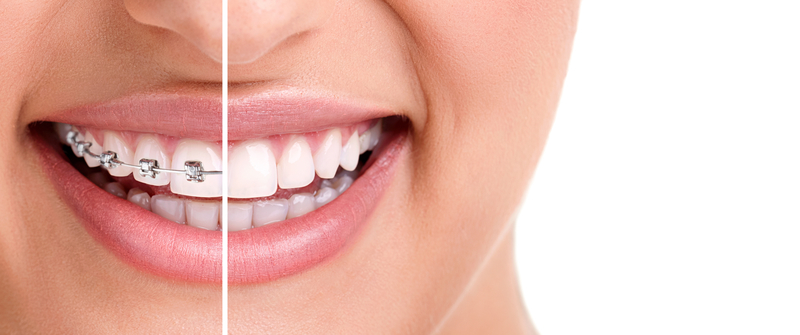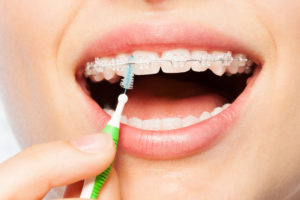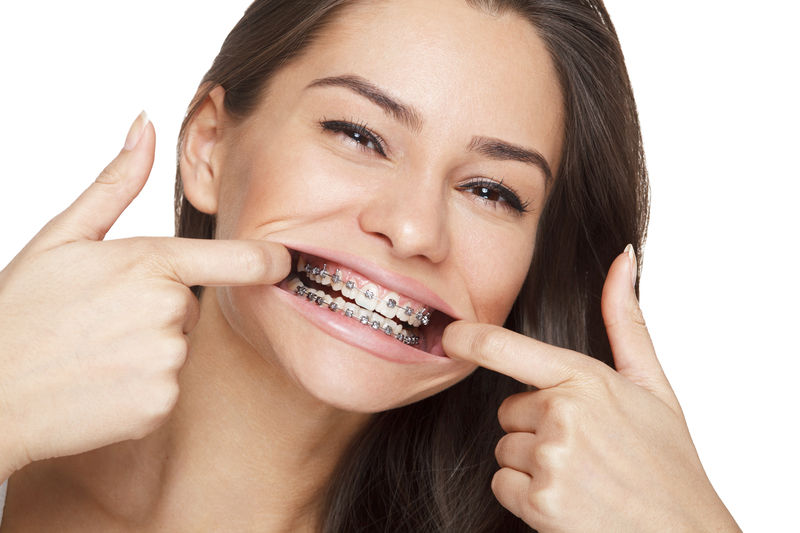Braces With Oral Health Problems

Did you know that your oral health can affect your overall health? Poor oral health can even worsen health conditions you already have such as diabetes or cardiovascular disease. That is because oral health and overall health are highly connected. Your oral issues can become better with braces, but that is only if certain oral health problems are corrected beforehand. Patients can also develop oral health problems if they don’t have the right knowledge with proper braces care. Use these tips to avoid oral health problems with braces and find out how we work around current problems to provide you with a straighter smile!
Oral Health Goals
Did you know that orthodontic treatment can give you a healthier mouth? We know that braces help straighten your teeth, but they can also improve the health of your gums and teeth. When you have crooked and crowded teeth, this makes cleaning your mouth more difficult. This can cause serious oral health problems, such as tooth decay, periodontal disease, and tooth loss. Whether you have straight or crooked teeth, before you let an orthodontist start working on you, there are some important oral health tips to be following before any work begins:
- Eat a healthy diet that limits sugary beverages and snacks
- See a dentist regularly for prevention and treatment of oral disease
- Brush teeth twice a day with fluoride toothpaste
- Floss daily
- Discuss changing certain lifestyle practices, like smoking and using oral piercings
Types of Braces
Braces are a big commitment, and you want to make sure you’re using the correct ones whenever you get them put on. Each of us is a different size and shape, and are mouths aren’t any different. Because of this, there are various types of braces for different sizes and shapes of mouths for children, teenagers, and adults. The four most common types of braces are: traditional, short-term, clear, and Invisalign/ClearCorrect.
Traditional braces are those that we see on a daily basis: a system of wires and brackets that are bonded to our teeth. This type of braces are the most cost-effective, reliable, and are best suited for severe orthodontic issues. Short-term braces are recommended for those patients who wish to align just their front six teeth-the ones that others see the most. These are used for the shortest amount of time (less teeth to align), but there is no adjustment to your occlusion (bite). So if you have a problem with an under/overbite, short-term braces may not be for you. Clear braces are similar to traditional metal brackets except that they use ceramic brackets that match the color of your teeth. These braces have a high aesthetic appeal for those who don’t want to be seen wearing braces, plus they are highly resistant to staining. Invisalign//ClearCorrect straighten your teeth without the traditional wire brackets, and are completely removable, which makes cleaning your teeth a cinch. This type requires more responsibility for the wearer, but if you’re committed to the strict wearing regimen, you can have a straight smile in as little as 12 months!
Taking Care of Your Braces

While similar to managing our oral health, maintaining our braces has a few extra steps. To maintain good oral health with braces, it’s important to adopt good oral hygiene throughout the entire process. Brushing after every meal is one of the most important but most overlooked steps in maintaining good oral health. When eating, food particles get stuck in between our teeth and our braces, which can cause staining and bacterial backup between our teeth. Using a regular soft brush in an up-and-down motion on each tooth will do the trick. Secondly, use threadable floss or a floss threader. These tools allow you to get between each tooth and underneath the wires to clean out any food that may be trapped there. Insert the threader between two teeth and move back and forth until the food is released. Lastly, use a proxabrush, or a “Christmas tree brush.” Place the proxabrush between two brackets, below the archwire, and brush up and down. Like the threader, this will also help loosen up any food that may be stuck between your teeth.
A great way to ensure that your braces don’t break and that you don’t get unwanted gunk stuck in them is to watch what foods you’re eating. Foods that are hard, sticky, or high in sugar should be avoided. Eating food that is high in sugar can cause cavities when wearing braces, which can lead to more dental work that you would need to have done. Furthermore, patients with braces should limit between meal snacks and avoid food that could bend the wires, such as caramel, nuts, chewing gum, ice, or popcorn.
When To See An Orthodontist
Now that we understand more about the importance of our oral health, plus the different types of braces, when should we make an appointment with an orthodontist? Many times, we only schedule a time to see an orthodontist whenever our teeth are crooked and we want them straightened. But there are other factors that influence when we should start thinking about getting in to see the doctor:
- Jaws that shift, make sounds, protrude, or are recessed
- Speech difficulty
- Biting the cheek or biting into the roof of the mouth
- Facial imbalance or asymmetry (features out of proportion to the rest of the face)
- Inability to comfortably close lips
- Grinding or clenching of teeth
As mentioned earlier, these are signs that your oral health might not be up to par like it should be. Meeting with your orthodontist and discussing these issues will help them better treat you with one of the four types of braces that we discussed previously. The sooner you get in to see your orthodontist, the sooner any pain or discomfort can be evaluated, treated, and extinguished.
Meet Your New Year’s Resolutions With Our Help!
Belmar Orthodontics can help you on your path towards having a straighter smiles and better oral health. With reputable orthodontists, manageable treatment plans, and services for children and adults, we can help you get the smile that you deserve! Call (303) 225-9016!
Tips for Success and Happiness with Your Braces

Many adults and teens feel like they will look childish with braces on. However, that still doesn’t stop more than 4 million people wearing braces each year in the U.S. Yes, braces are harder to clean and require more care. However, that care only takes a few extra minutes each day, and you have orthodontic options that can make you extremely happy with your braces. Find out how you benefit from orthodontics!
Your First Week with Braces
When you first get brackets and wires on your teeth, you will have tooth sensitivity for a few days. That sensitivity and soreness will wear off, but during that time, stick to soft foods such as pasta, yogurt, mashed potatoes, etc. Over-the-counter painkillers (like acetaminophen) can help curb pain that first week and at each braces adjustment.
Your braces will feel bulky in your mouth at first, but will quickly start to feel normal. Even though there are changes with braces, you can be successful with your treatment if you do everything the orthodontist tells you. This includes using your bands like they tell you, having good oral health and avoiding foods that can cause you trouble.
There are foods you want to avoid that will either break your brackets or wires or that will become stuck in them. Many foods on this list are also full of sugar, which is what makes plaque that coats your teeth. When plaque sits on the teeth, it decays them and erodes them. Avoid foods like:
- Hard candies
- Chewing on ice
- Apples, carrots, and hard fruits and veggies
- Popcorn (because of kernels), nuts and chunky peanut butter
- Chips and hard snacks
- Caramels, licorice, taffy, Tootsie Rolls, Starbursts, Sugar Daddies, Skittles and similar candies
- Corn on the cob
- Dried fruit, fruit snacks and gummies (which get stuck in brackets and teeth)
- Gum

Taking Care of Your Teeth
Caring for your teeth through proper oral hygiene is essential if you want to love your braces and if you want your teeth to be in good shape when they come off. Patients who skip brushing and flossing will end up with tooth decay, tooth erosion (worn away areas of the teeth) and stains on their teeth when the braces come off. Don’t let that be you! Follow these tips for taking care of your braces successfully:
- Brush, brush, brush! Aim for three times a day instead of just the recommended two times. The American Dental Association recommends that patients brush for at least 2 minutes every time, at least morning and night. Choose a soft-bristled toothbrush that will be more gentle on your teeth and switch out your brush every 3 months.
- Floss your teeth. Flossing is the thing that is most often skipped, especially by children and teens. However, flossing gets about 40% of your tooth surfaces that brushing misses. It is one of the only ways to dislodge stuck food that will decay your teeth. Floss 1-2 times a day. However, invest in flossers or threadable floss, which you can pull through the cracks in your teeth, getting under the wires. This makes flossing so much easier.
- Use a Waterpik and brush. Patients often get food stuck in their teeth that flossing and brushing can’t get out. A waterpik is a small device that shoots water. You shoot the water where you want to dislodge the food or particles in brackets or in between the teeth. A braces brush looks like a tiny Christmas tree. It can get all the gunk out of your brackets and wires with ease.
- Don’t chew on non-food items! Pencils, fingernails, and any other hard item can break your braces.
Benefits that Braces Can Give You
Some patients love their braces, while others don’t. If you are the latter, just remember why you are getting braces: you are looking forward to that beautiful, straight smile. You only have braces on for 1-2 years. If you get through that time, you get to have a straight, beautiful smile for life. Studies show that your smile goes a long way as well. It’s one of the first things others notice about you. In studies done about straight teeth vs. crooked teeth, the impressions others got were quite impressive:
- Invisalign (Align Technology) found that people with straight teeth were 45% more likely to be hired for a job.
- They were seen as 58% more likely to be wealthy and successful.
- People perceived people with straight teeth as healthier, happier, and even smarter than others.
- A whopping 73% of people were more likely to trust someone with straight teeth as well!
Whether you love your braces or not, just remember the amazing benefits that come from having a straight smile. It will not only improve your social life, but straighter teeth are easier to clean and less prone to tooth decay and oral health diseases as well.

Being Happy with Your Braces
The best way to be happy about your braces is to choose braces that you love. Some patients prefer metal braces because they are the most economical choice, while others like Invisalign because they are removable. Patients also enjoy clear, ceramic braces that are like traditional braces, but made from white, ceramic material. If you want the sturdiness of metal braces, but want them hidden like Invisalign, you can also choose our lingual braces option.
These are braces hidden behind the teeth. If you are self-conscious about your appearance and want to straighten your smile quickly, this may be the option you want. No matter what you choose, remember that this is your only time with braces! Enjoy going through this journey and even get your braces at the same time as your friends to make it more fun. For tips about adjustments, appointments and any extra tips for your braces, call Belmar Orthodontics today at (303) 225-9016!
Dentistry and Orthodontics Are Closely Related

Dentistry and orthodontics are quite different, but they are also closely related. You need care from both a dentist and an orthodontist in order to keep your smile healthy. Dentistry and orthodontics both deal with the health of your smile. One focuses on straightening the smile and other focuses on tooth decay, gum disease and treatments to help correct oral issues. Both involve services that “fix” problems with the teeth to help make your mouth healthier, thus making you healthier. Find out the difference between dentistry and orthodontics, the similarities, and how both can help you have the best smile possible.
What Dentists Do
Dentists go to school to specialize in problems involving the teeth, nerves, gums and jaw. They can provide any or all of the following services:
- Comprehensive exams and dental cleanings
- Oral cancer screenings
- Sedation dentistry
- Laser cavity detection and cavity detection using x-ray imaging
- Tooth extractions
- Laser tissue treatment
- Oral hygiene training
- Dental sealants
- Periodontal treatments on the gums
- Scaling and root planing for gum disease
Dentists are also trained in cosmetic dentistry and can provide services such as dental implants, porcelain veneers, porcelain crowns, cosmetic bonding, dental bridges and even botox treatment. Restorative dentistry involves root canals and root canal therapy, teeth-whitening services, tooth-colored fillings, and in some cases orthodontic care through Invisalign. The dentist is usually trained in orthodontics to provide this service. If a dentist finds that a patient has a problem with their bite or alignment, they will refer the patient to an orthodontist who is certified and trained to correct the issue.
What Orthodontists Do
Orthodontists must obtain several degrees to become orthodontists. They need more training than dentists do because they must be able to correct smiles as well as identify oral health issues. Orthodontists are specially trained with correcting bites, occlusion (or alignment), and in straightening the teeth. In a healthy mouth, the upper jaw rests on top of the lower jaw. The upper front teeth will rest slightly forward on top of the lower front teeth. Not all mouths are aligned correctly. Some bites that orthodontists correct include:
- Overbite – In the upper jaw, the front teeth rest over the lower front teeth instead of above. You never want the front teeth to overlap the bottom teeth completely, as this creates pain and other problems when biting, eating, and other everyday tasks.
- Underbite – This is the opposite of overbite. The lower front teeth rest far in front of the upper front teeth. This creates similar jaw problems as mentioned with overbite. Underbite can lead to jaw and joint pain, earaches, headaches. and more.
- Crossbite – Crossbite involves teeth that cross in all different directions. Some of the teeth are slanted toward the tongue. Other teeth are slanted towards the cheeks. This creates uneven pressure all over the mouth when biting and chewing, which can lead to broken or fractured teeth, weakened enamel, pain, and more. Crossbite can even cause abnormal facial development and jaw problems if left untreated.
- Openbite – Openbite refers to an opening (or gap) in the teeth between the upper and lower jaws when the mouth is closed. This gap is right at the front of the teeth and might even appear as a hole in a patient’s smile. Openbite leads to speech impediments, lisps and other problems with speaking if left untreated.
Dentistry and Orthodontics Compared
Did you know that an orthodontist has dental training? Orthodontists must obtain several degrees in order to work. They must obtain a Doctor of Dental Surgery (DDS) degree or a Doctor of Medical Dentistry (DMD) degree just as dentists do. Then, they must apply to an orthodontic graduate program to obtain a Masters of Science degree. Orthodontists go through all the same training as dentists and then some. This is how orthodontists can spot dental issues forming. Basically, all orthodontists are dentists but not all dentists are orthodontists.
If you have problems with your teeth, gums, oral nerves or jaw, then go see your dentist. Your dentist will refer you to an orthodontist if the issue is corrected by an orthodontist or has to do with bite, alignment or straightening. When it comes to problems such as tooth decay (cavities), both dentists and orthodontists can help you in some way. Orthodontic care via braces can help straighten the teeth, thus making them easier to clean and reducing your risk for tooth decay. Dentists can also help you prevent tooth decay with comprehensive exams, biannual cleanings and treatments that stop the progression of cavities if they have formed.
Benefit From Both
Both dentistry and orthodontics involve services that “fix” problems with the teeth to help make your mouth healthier, thus making you healthier. Both professions involve doctors who are highly trained to help problems with your oral health. Patients can benefit greatly from having both a dentist and an orthodontist. Take a step towards a healthier mouth, and schedule an appointment with Dr. Hardy today by calling Belmar Orthodontics at (303) 225-9016!

